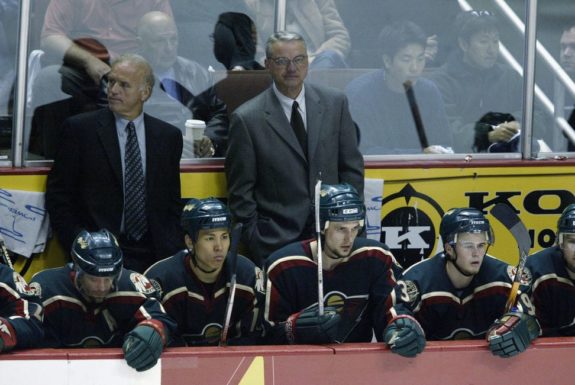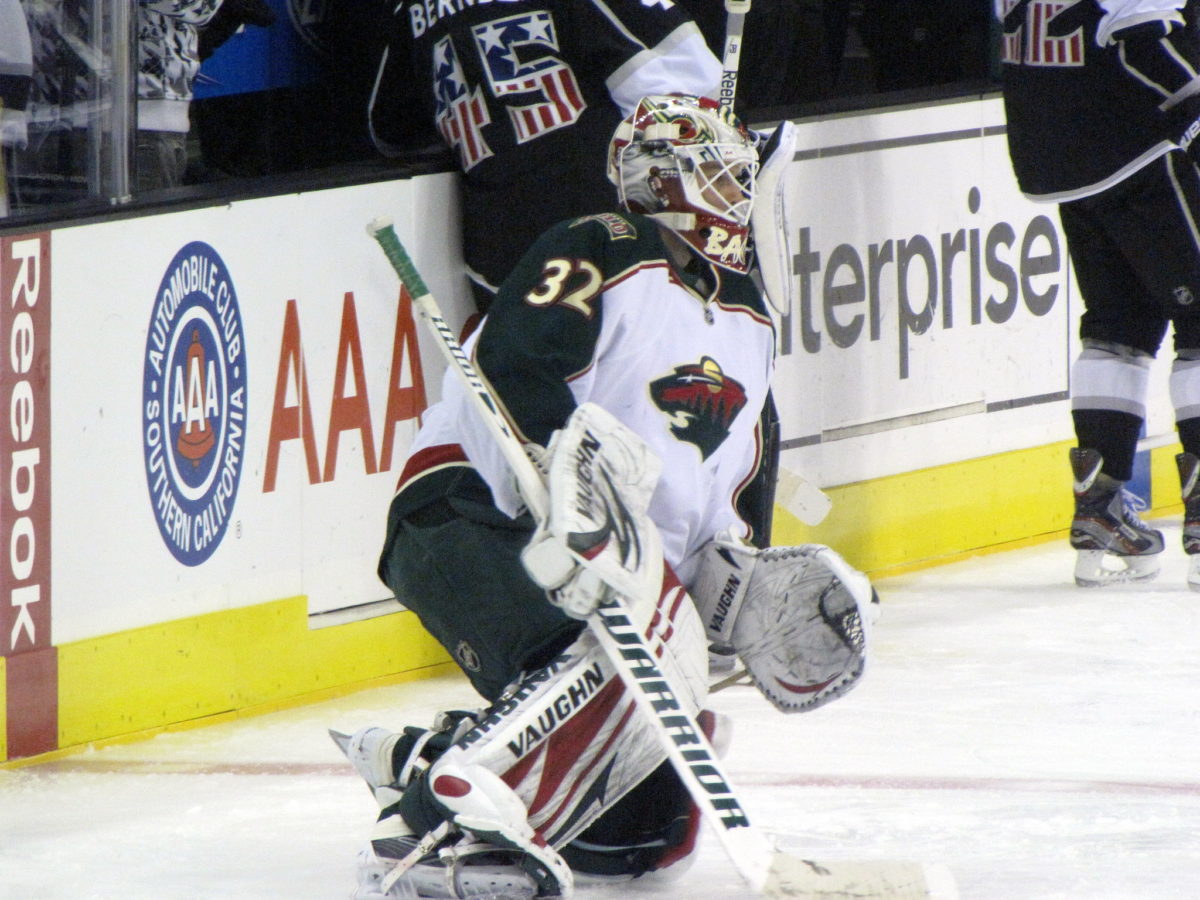Defense and goaltending.
Those are two aspects of the Minnesota Wild’s identity that have been prevalent through most of the team’s 21-year history. While we recently looked at the highest-scoring teams in the franchise’s history, it’s time to shift the spotlight onto the five Wild teams that allowed the fewest number of goals in an NHL season. Just like with the highest-scoring teams, this list will be sorted by goals against per game (GA/G) to make it fair for the rosters that lost games due to a lockout or COVID-19-shortened season.
While the Wild have put more of an offensive touch on things in recent seasons, the 2020-21 team is doing a good job at keeping the puck out of the net. As of March 29, Minnesota is allowing 2.44 GA/G, which is good for sixth-best in the NHL. Outstanding defensive performances, as well as Kaapo Kahkonen’s play in net, have been contributing factors to the low goals against count.
Read on to see where this season’s Wild team ranks on the all-time list for lowest goals allowed per game in franchise history.
5. 2008-09 NHL Season: 2.44 GA/G
As is the case for most of the teams on this list, the defensive-minded Jacques Lemaire was behind the bench for the 2008-09 Wild team. Lemaire is known for perfecting the neutral zone trap, which ended up limiting how many goals opposing teams scored on most of the teams he coached for.

In 2008-09, the Wild allowed just 200 goals on the season, second-fewest in the NHL. Only the Boston Bruins (196) allowed fewer. A big part of this success was Niklas Backstrom’s play in net. The Finnish goaltender finished the season with a 37-24-8 record, along with a .923 save percentage (SV%) and 2.33 goals against average (GAA). These totals earned Backstrom a spot as a Vezina Trophy finalist; however, he ultimately lost the award to Tim Thomas.
Kim Johnsson was one of the Wild’s top defenders that season. His defensive point shares (DPS), the number of points a player contributes to his team from his defense, was 5.7, tied with players like Nicklas Lidstrom and Zdeno Chara for fifth in the NHL. Johnsson also contributed by blocking a career-high 142 shots that season.
Despite the Wild’s defensive and goaltending efforts in 2008-09, it wasn’t good enough to make the playoffs, missing out on the postseason by two points. After the season finished, Lemaire stepped down as head coach to return to the New Jersey Devils.
4. 2020-21 NHL Season: 2.44 GA/G
While there’s more hockey to be played this season, the 2020-21 Wild have been playing well this season. They ranked fourth for most goals per game in a Wild season last week, and here they are at No. 4 for fewest goals allowed, edging out the 2008-09 roster by a few decimals places before rounding up.
In his first “full” season as Minnesota’s head coach, Dean Evason has been doing a good job at getting his team to buy into his playstyle, especially after their mid-February COVID-19 hiatus. To put things into perspective, the Wild are 21-3-0 when keeping the opposing team to three or fewer goals this season. A large part of this success has to do with how well the tandem of Kaapo Kahkonen and Cam Talbot has been playing.
As of March 29, this is how both goalies’ statistics are looking like:
- Kahkonen: 12-5-0, .921 SV%, 2.29 GAA, two shutouts
- Talbot: 9-5-1, .925 SV%, 2.34 GAA, two shutouts
However, it isn’t like the goalies are playing alone out there. The Wild’s defensive core has been a big factor as well. Jonas Brodin (60), Jared Spurgeon (55) and Ian Cole (52) are in the top-30 for blocked shots in the NHL. The team has also had solid defensive contributions from Carson Soucy, who’s been putting together the second of back-to-back defensively-sound seasons for the Wild. Should the team have their sights set on the Stanley Cup, they’ll need to continue playing as they have from both sides of the ice.
3. 2006-07 NHL Season: 2.33 GA/G
Third on the list is another Lemaire-coached team. Much like his other teams, the 2006-07 Minnesota Wild squad was incredibly hard to score against. They allowed just 191 goals, which was the best total in the NHL that season. Due to that statistic, Niklas Backstrom and Manny Fernandez shared the William M. Jennings Trophy for the fewest goals allowed. Backstrom also won that season’s Roger Crozier Saving Grace Award for the goalie with the best save percentage (.929 SV%).

Outside of goaltenders, the Wild had support on the back end. Martin Skoula (5.3 DPS) and Keith Carney (5.2 DPS) contributed well defensively. Both defensemen finished in the top-20 for defensive point shares. The team even had three 20-goal scorers that season, so you could say that it was balanced at both ends of the ice.
Unfortunately, that stopped when the playoffs began. The Wild were eliminated 4-1 by the Anaheim Ducks in the first round of the playoffs, but not because of a lack of defense. They held the Ducks to just 12 goals in five games. On the other hand, the Wild only scored nine, and it’s hard to win games when you’re averaging less than two goals per game.
2. 2003-04 NHL Season: 2.23 GA/G
The 2003-04 Minnesota Wild roster is the first pre-2004-05 lockout team to make it on the list. This team played during the “Dead Puck” era when scoring was at a low for the NHL. The fact that Lemaire enjoyed using the neutral zone trap didn’t make it any easier for teams to score during this period. It also helped that Minnesota had a strong tandem of Fernandez and Dwayne Roloson to rely on in the crease. While the former looked decent, it was the latter who stole the show that season. Despite his 19-18-11 record, Roloson had a .933 SV% and 1.88 GAA, numbers you don’t see too often anymore in today’s game. He also won the Roger Crozier Saving Grace Award that season.
At the end of the day, despite having the second-lowest GA/G in franchise history, the 2003-04 Minnesota Wild were one of the worst teams in the league that season. The club finished fifth-place in the now-defunct Northwest Division. They also only scored 188 goals, one of the lowest totals the team has ever had. Alexandre Daigle was the Wild’s sole 20-goal scorer, and that’s just one of the many reasons the team took a step back.
Even though this is one of the team’s best defensive and goaltending rosters, a lack of goal-scoring left Wilds fans feeling disappointed after seeing the team play in the Western Conference Finals the previous season.
1. 2002-03 NHL Season: 2.17 GA/G
The 2002-03 NHL Season is seen by some as being the best in franchise history, even nearly 18 years later. It was just the third season in the club’s history, yet they happened to have a magical run that saw them get swept by the Ducks in the Western Conference Finals.
However, the Wild allowed only allowed 178 goals that season. To put that into perspective, the team allowed 127 goals in 48 games during the lockout-shorted 2012-13 NHL Season. It was incredibly hard to put the puck past Roloson and Fernandez, with each goalie sporting a save percentage of .924 or better. Lemaire also deserves credit for how well the Wild played that season. The team finished with 68 and 73 points in their first two seasons, only to jump to 95 in 2002-03, leading to Lemaire winning his second Jack Adams Award for the top coach in the league.
When the playoffs began, nobody expected the sixth-seeded Wild to make too much noise. However, the playoffs saw a fantastic goaltending performance from Fernandez in the first round against the Colorado Avalanche. After being down 3-1 heading into Game 5, the team shifted from Roloson to Fernandez, who’d win the next three games for them while only allowing two goals each game.
While the Wild’s goaltending and defense remained strong for a majority of the playoffs, the offense failed to show up in the third round against the Ducks. The team scored a single goal in the Western Conference Finals, getting shutout in the first three games in the series before losing 2-1 in Game 4. Nevertheless, it was still a season to be proud of.
In Conclusion…
If one thing is certain, it’s that the Wild have had consistently good defense and goaltending throughout franchise history. While most of these occurrences happened early in the franchise’s history, this season has shown that they’re still capable of doing that.
The main issues that these past teams faced were that the goal-scoring disappeared when the club needed it the most. Fortunately, for this season’s team, the Wild are in the top-10 for both goals scored and allowed in the NHL. If they can keep this trend going into the postseason, they could possibly find success that the organization hasn’t seen since the fabled 2002-03 playoff run.